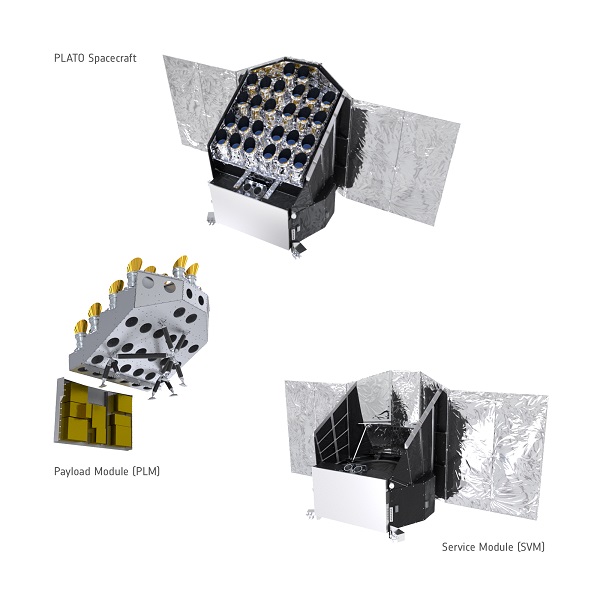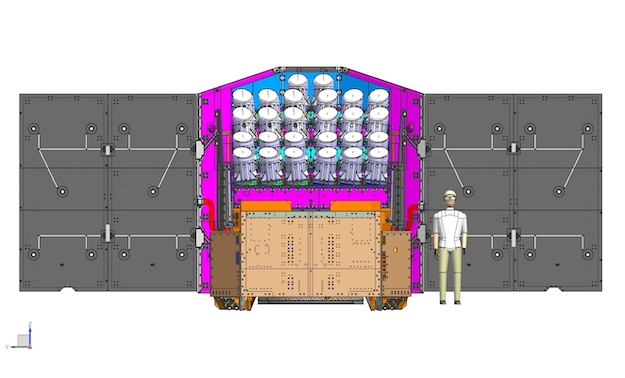Spacecraft
The PLATO spacecraft is a 3-axis stabilised system with a launch mass of 2500 kg, including consumables, a size of about 3.5 m (x) × 3.6 m (y) × 3.7 m (z) in stowed configuration, and a deployed wing span of approximately 9 m. It is designed to meet the main mission specific requirements:
- Accommodate a large payload of 26 cameras and protect it from exposure to the Sun
- Operate for up to 8.5 years at the second Lagrange point, L2 (nominal mission duration 4.5 years)
- Provide a stable pointing for long duration observations
- Transmit a large amount of scientific data to Earth
To achieve this, the spacecraft consists of two main modules: the Payload Module and the Service Module.
 |
| The PLATO spacecraft and its two main modules. Credit: ESA/ATG medialab |
The Payload Module, which accommodates the cameras, is mechanically decoupled from the rest of the spacecraft by means of a truss structure with flexible joints (this ensures a quasi-isostatic support necessary to maintain the required pointing). The module is mostly made of carbon fiber to increase stiffness and reduce thermo-elastic deformations. It includes a radiator panel (made of aluminum) where all the payload electronic units are accommodated.
The Service Module contains all the systems necessary to operate the spacecraft in the designated orbit. It includes:
- a sunshield to protect the cameras from the Sun, that also carries the solar panels (three panels mounted on the spacecraft body and four deployable panels on two wings) necessary to provide power (3000 W) to the satellite;
- a propulsion system (a blow-down, monopropellant system) necessary to reach and maintain the orbit;
- an attitude control system based on reaction wheels, thrusters, gyros, sun sensors and star trackers required to control the pointing;
- a communication system in X-band (for the satellite control) and K-band (for science data transfer at high data rate, up to 72 Mbps) with a steerable high-gain antenna and three low-gain antennas (two of them fixed and one steerable);
- a thermal control system based on heaters, radiators and multi-layer insulation (MLI) to provide the required temperatures to all the units;
- a control and data management system to oversee the operation of the satellite, receive commands and control all the autonomous functions, including dealing with potential anomalies.
All electronic units are accommodated on the lower panel that acts as a radiator. The structure, based on a carbon fiber central tube and shear panels, provides the interface to the launcher as well as a stiff base for the payload module.
 |
| PLATO spacecraft exploded diagram. Credit: ESA/ATG medialab |
| PLATO spacecraft size. Credit: OHB System AG |
From a technical point of view, the main challenges are related to the very accurate thermal control required by the cameras to provide high-quality photometric measurements, as well as to the control of the thermal elastic deformations of the payload module. The latter ensures the pointing stability of the cameras, minimisation of stray light effects and a robust failure management system, which in turn makes sure that the cameras are never exposed to the Sun, as this would permanently damage them and bring the mission to a premature end.
The spacecraft is designed and built by a pool of European companies led by the PLATO Core Team (OHB, ThalesAlenia and RUAG).



